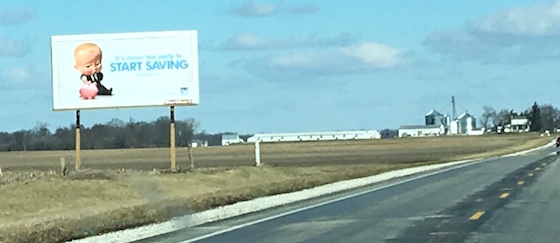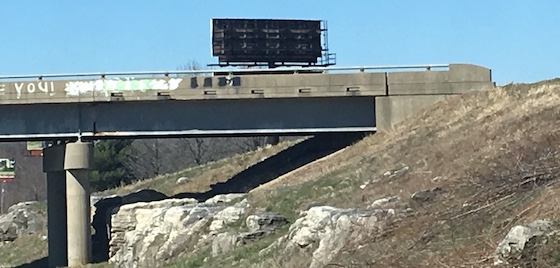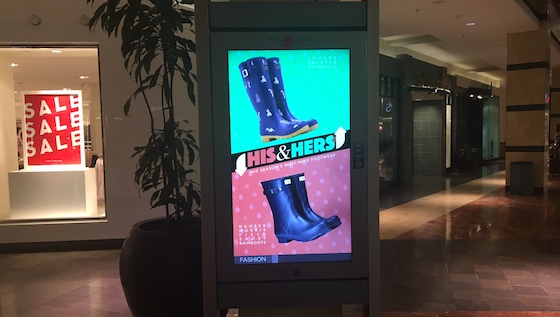Memo From Frank
It’s 100 degrees out and that sounds like a good-time for an ice-cold Coke. Why do I think that? Because Coca-Cola has been promoting that concept for over a century in the U.S. – and a huge portion of that money was spent on billboards. In fact, Coca-Cola has probably been the longest-running advertiser in billboard history, as well as one of its biggest advocates. If you look through books of famous billboards, you will find that Coke is a frequent winner of the “best ad” category, and that’s from the 1920’s to current. So here’s to Coca-Cola – a lifelong fan of the billboard product, a huge financial supporter of the industry, and the creator of one of the best drinks when it’s hot out!
How Much Does That Sign Make? A Primer On Billboard Economics

Billboards are a fairly simple economic engine. Their numbers are pretty similar regardless of the type of sign, with the same basic expense categories whether it’s a 12’ x 24’ (like the sign shown above) or a giant 20’ x 60’ monopole. So how do the economics work, in general, on a typical billboard?
Revenue
The only revenue that a billboard produces is from ad space. There are no other income possibilities. So the potential revenue of the sign is the sum of the potential ad space rents. Since most billboards have two faces, that means that there are two sources of revenue. But LED signs can have as many as eight different advertisers, and stacked billboards can have four.
Expenses
There are only a handful of expense line items for the average billboard. These include ground rent, electricity, vinyl installation and/or production, personal property tax, insurance, and repair & maintenance. The industry norm is around a 30% to 40% expense ratio.
Net Income
Net income on a billboard is a simple formula: revenue minus expenses. Given the typical expense ratios, it’s a safe assumption that the net income should be 60% to 70% of revenue. But that’s assuming, obviously, that the ad faces are rented. In making projections on building or buying billboards, it’s always a good idea to factor in some degree of vacancy. You should also give yourself a buffer on potential revenue to make allowance for having to lower rents in the event of a recession, etc.
Sample
Here would be the economic model for a sample 14’ x 48’ steel monopole billboard. The revenue, in this case, would be $3,000 per month, based on an ad rent of $1,500 per month per face. So that’s $36,000 per year coming in. The expenses would be 20% ground rent.
Conclusion
Billboards have simple economics. It’s one of the most unsophisticated business models ever devised. And unlike most businesses in today’s high-tech world, a simple business model allows you to become an expert at it quickly and make money rapidly.
Billboard Home Study Course
![]() How to Find a Billboard Location
How to Find a Billboard Location
![]() How to Buy a Billboard
How to Buy a Billboard
![]() How to Build a Billboard
How to Build a Billboard
![]() How to Operate a Billboard
How to Operate a Billboard
![]() How to Rent Ad Space on a Billboard
How to Rent Ad Space on a Billboard
![]() How to Sell a Billboard
How to Sell a Billboard
Get Your Copy Now!
A Check-Up On Your Financial Health – And How Billboards Might Help You Out

You go to the doctor to try and prevent big health problems. But how do you get a check-up on financial problems, and how do you solve those issues? For many people, billboard investing is an obvious answer.
Saving money in a modern America is impossible
The financial experts agree that you need enough assets that around 4% interest on those assets will pay all of your bills in retirement. Assuming you need $50,000 per year to retire, for example, that would require around $1,250,000 in investable assets. So unless you can quickly save up that much (and you’ll have to earn an extra $2,000,000 to hit that number after taxes) you simply do not have savings as an option to solve your financial needs.
Building income streams is easier
So if saving $1,250,000 is impossible, the easier alternative is to simply build an income stream of $50,000 per year. When you build an income stream, you don’t have to start by amassing assets, you have to start by creating opportunities that yield cash flow. It’s the same as your day job – you show up for work and you get a paycheck regardless of how much you’ve saved in the past.
Billboards make for great sources of income
When it comes to ways of creating additional income streams, billboards are a great option. The require low amounts of capital, have extremely high levels of return, and require very low management effort. Take a wooden billboard, for example. An average wooden billboard on a two-lane highway can earn around $3,000 per year. About 15 of those will earn you $45,000 per year – and your financial problem is solved. 30 of those will make you around $100,000 per year.
And they mix well with your day job
Billboards do not require you to quit your day job. In fact, they complement it, with the management side of the business fitting well into strictly nights and weekends. You can build a fairly sizable portfolio of billboards without any ill effects on your profitable day job. You would be amazed at how many people who own billboards also have regular 9 to 5 day jobs.
Conclusion
Unless you are capable of earning and saving over a million dollars, you are better served with owning billboards. That’s the cure for your financial ailment, and it’s been working for smart investors for decades.
When Is An Obstruction A Deal Killer?

Billboards are all about visibility. So when a sign has some type of blockage, it’s always a very difficult decision as to whether to build it or not. How can you decide whether or not an obstruction renders a potential location or acquisition a failure?
Length of read
Studies have shown that the average length of billboard visibility is around 400’. Farther than that, and you typically can’t read the ad message. But shorter than that, and you normally can’t read the whole message. So the starting spot in evaluating the damage that an obstruction creates is to factually measure how many feet of clear read the sign has.
When the obstruction occurs: the beginning or the end
Another item to consider in evaluating blockage is whether it occurs at the beginning or the end of the approach to the sign. Most advertisers prefer the blockage to be at the farthest distance from the sign, as you can barely make out the words at 400’ back, and the letters are much larger at 200’ or so. That does not mean that a sign that has an obstruction right before the end of the read is worthless. You can still overcome that problem sometimes by making the words on the sign fewer and larger.
Can the obstruction be removed?
One way to solve the whole visibility problem is to simply remove the obstruction. This is sometimes remarkably simple to do. I once purchased a billboard from what is now Clear Channel. The sign had been blank for a decade. The reason they could not rent it was that it had a giant “Park Here” sign for a parking lot right in front of it. I called the parking lot owner after I bought it, and asked them if I could lower their sign so it was no longer obstructing the billboard. To my amazement they said “sure”. So why had Clear Channel not done the same thing? I’m not sure. Probably the owner of the parking lot changed at some point over the decade, and the had never talked to the new owner. In another case, I was able to pay a neighboring property owner to cut down a tree. I paid them around $1,000 and unlocked around $10,000+ in value.
Can the ad space be rented despite the obstruction?
If the obstruction cannot be removed, then the other option is to build or buy the sign and rent it anyway. Even signs with short reads can still be of value to an advertiser in many cases. However, this is on a case-by-case basis. If you have a sign where the short approach is blocked, you might still be able to rent it to a McDonald’s with nothing more on it that the McDonald’s logo and the exit number is giant letters. I’ve even rented signs that had half of the ad face completely blocked by designing an ad that was shaped like a long rectangle, or an ad that was shaped like a square. To make a blocked sign marketable you have to be creative and also have a location with enough demand that people will want to rent the ad space even though it is flawed.
Special cases
One of the items that needs to be discussed in any discussion of billboard blockage is the law. You cannot simply go out and tear down an obstruction without permission. In some states, you would be guilty of breaking the law, and the penalties can be huge. Trimming a tree on the State of Texas right-of-way can result in a fine of $10,000. In some situations in life, it’s easier to ask forgiveness than permission. This is not one of those times.
Conclusion
Since visibility is a big part of the value of a billboard, the absence of perfect visibility is a very important issue. In many cases, blockage can be resolved, and in others the blocked sign can still be income producing.
The Adaptability Of Multi-Face Signs

In many states, multi-faced “stacked” signs are very common. While these were designed to handle two advertisers, today you will find many advertisers who rent both panels. In fact, there are many creative ways to adapt the stacked sign into one giant panel.
Understanding the laws
Some states have specific laws concerning combining stacked signs together. They do not allow you to physically connect the two ad faces. However, they may allow “extensions” which are embellishments that extend beyond the borders of the ad. In those cases, you can make the sign “appear” to be connected. In other states, there are no laws regarding connecting the signs together, and you can literally stick a panel between the two signs and make one giant ad face.
Adapting to changing demand
One benefit of the stacked sign is that you can either have one advertiser at one price, or two advertisers at half that price. Or you can have four advertisers at a quarter of the price – by splitting each panel into two ads yet again. This allows for a path to hitting your budget regardless of the local economy. I once owned a billboard on Wilshire Blvd. in Los Angeles that had two panels. One year it would have two advertisers, and the next year it would have one. I appreciated that I had the option to be flexible and still hit my revenue budget.
Conclusion
Stacked signs are not all about having two advertisers. They are more about adaptability to meet market condition and still hit budgeted revenue numbers. In troubled times, such as after the 2007 Great Recession, this flexibility is extremely important.
Outdoor Advertising + Creativity = Big Money

Do you have the next big idea in out-of-home advertising? You might. There have been many new out-of-home advertising models that have been built over the past several decades.
Opportunities are all around you
While the billboard sector is only one branch of it, the out-of-home industry is giant. It includes every form of advertising that is conducted outside of your home, such as transit advertising, airport advertising, mall advertising, supermarket advertising, gas station advertising, etc. The good news is that all out-of-home business models use the same basic dynamics, so you can take your billboard knowledge and apply it to other concepts, as well.
Harnessing traffic – both car and foot
Any place that has significant traffic – both auto or pedestrian – is a potential place for an out-of-home project. So think about where you see humans or cars in bulk. Sporting fields, parking garages, theaters – anyplace – is a potential business model. Your goal is to 1) locate the traffic area 2) come up with a out-of-home method of advertising to these individuals 3) get permission to build the signs and 4) rent the ad space. Although billboard signs are Federally regulated by the U.S. government, most other out-of-home concepts do not require any city, state or federal approval.
Building a test case
Once you have the business model perfected, it’s time to build a test case. This is an important step, because you need at least one successful location before you can build more; basically a portfolio piece. Once you have at least one successful model that has been created, it’s time to expand that model to as large a size as you desire.
Expanding rapidly
Once you have a successful prototype, it’s incredibly easy to expand on that. Look at Lamar Outdoor’s logo-sign program on the highways. Once they got it down, they were able to go nationwide very rapidly. It’s much, much easier to expand a successful test case than to build the original prototype itself. Since these type of programs yield significant incremental revenue to the land owner, it’s not hard to get a huge amount of interest in your expansion.
The power of volume
If you were able to build an out-of-home prototype that yields $18,000 per year, and expand it to 30 locations, that’s $540,000 per year to you, the owner. That’s the power of volume and that’s true of all outdoor advertising models. The billion dollar fortunes of the leading out-of-home owners began with a single wooden sign or a single ad in an airport.
Conclusion
Learning about how to build, buy and operate billboards is an important skill. But it also opens the doors to many other out-of-home opportunities. The possibilities are endless in the out-of-home universe – and so is the profitability.
Who Are The Biggest Billboard Users In The U.S.?

McDonalds has been one of the largest billboard advertisers in the U.S. for over a half century, currently ranked as #2 in total billboard dollars spent, with $73 million in spending. But who are the other giant billboard advertisers in the U.S. and what do they spend? Here are the stats from 2015:
- #1 is Comcast at $82.7 million spent
- #2 is McDonalds with $73.6 million spent
- #3 is Time Warner at $62.7 million spent
- #4 is Apple at $59.7 million spent
- #5 is T-Mobile at $54.8 million spent
- #6 is Verizon at $47.9 million spent
- #7 is 21st Century Fox at $43.8 million spent
- #8 is Coca-Cola at $42.7 million spent
- #9 is Walt Disney Co. at $40 million spent
- #10 is Miller/Coors at $35.5 million spent
The Market Report
Prices Are Delayed By At Least 15 Minutes
